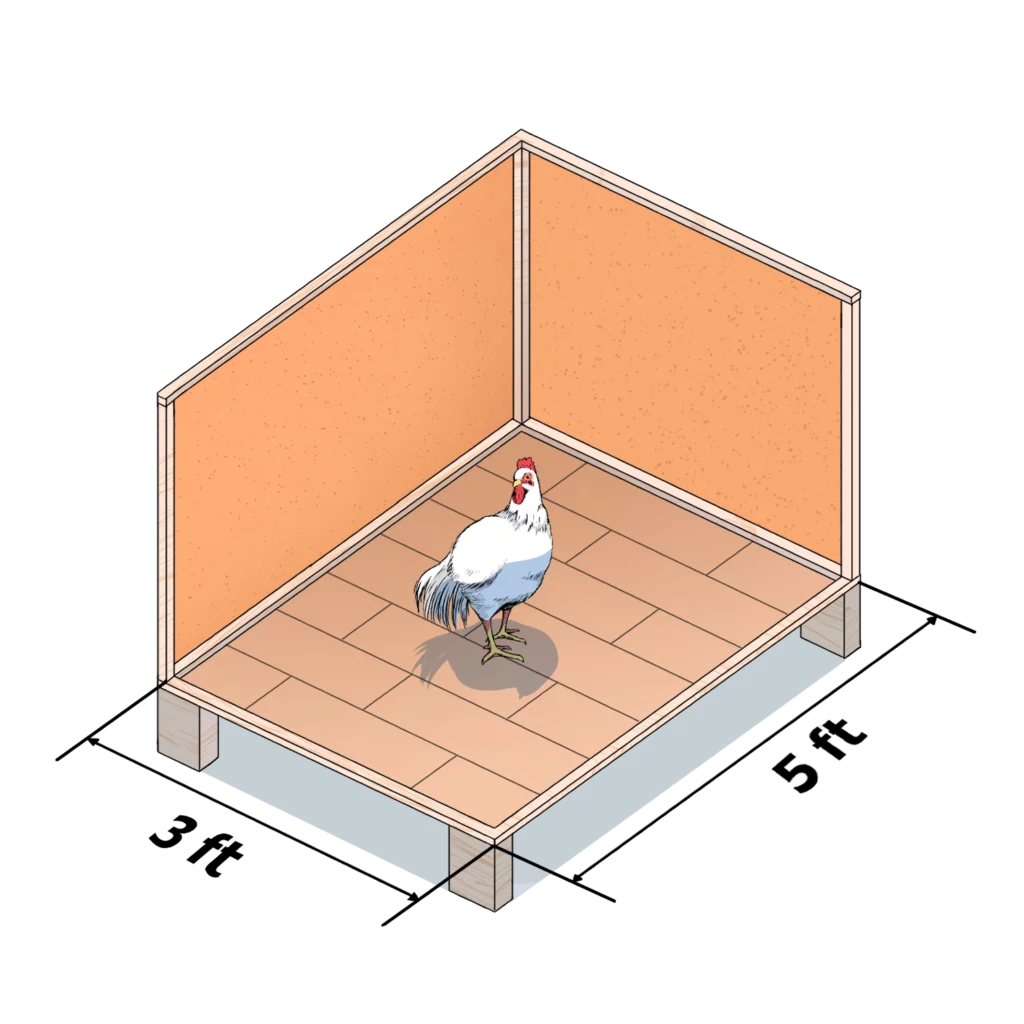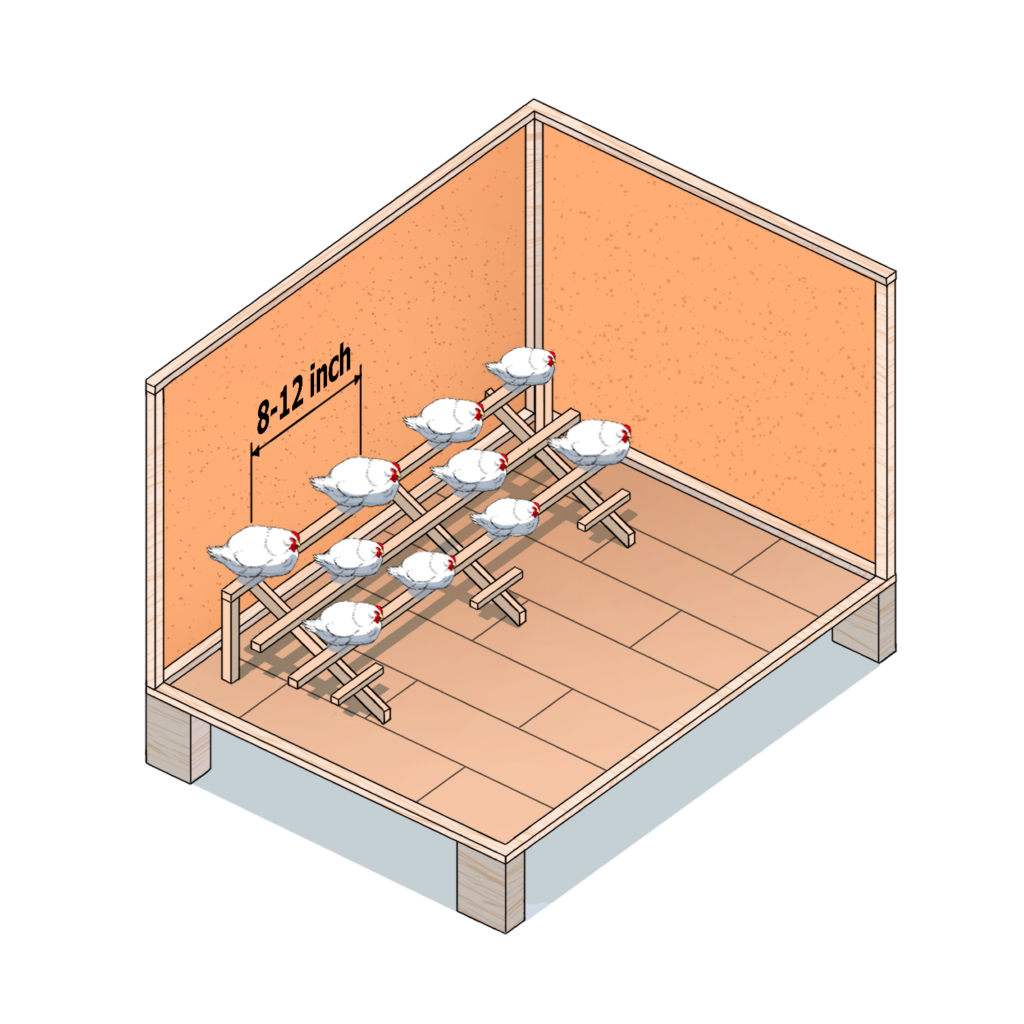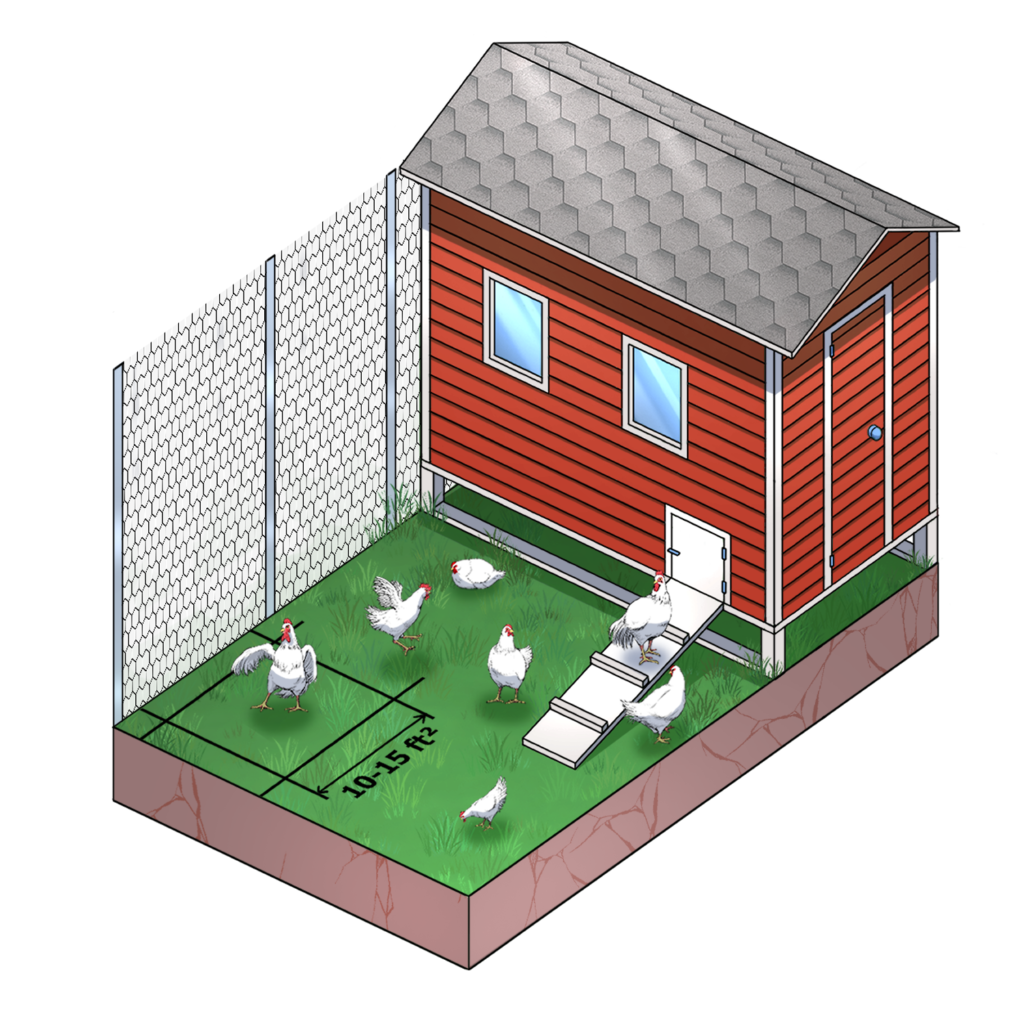Published on ; Last updated on ;
Chickens are generally easier to raise than most other barnyard animals. However, raising even the smallest flock can be overwhelming if you don’t know a few specific rules. No matter the size of your flock, you want to provide your birds with a healthy environment where they can coexist comfortably. For the most part, this means providing them with adequate space.
So, how much space do chickens need? It’s essential to consider any local laws, chicken coop permits, or guidelines that may dictate the number of chickens and minimum space requirements for chickens in your area. There are a lot of factors that go into determining the amount of space each bird needs. Chickens are social animals and will appreciate an ecosystem where they interact with each other but still have room to forage individually. Chickens also develop a very complex pecking order within the flock that can create aggressive interactions in the flock if they lack space.
If you are new to keeping chickens, space is one of the most important aspects of a flourishing poultry flock. In this post, you will learn about your chickens’ needs, emphasizing the amount of space they need to stay happier and healthier.
How much room do chickens need?
Chickens enjoy moving around freely, stretching their wings, foraging. Not providing your chickens adequate space can cause many problems, including stress, cannibalism, pecking, and infections.
That said, how much space your chickens need depends immensely on the breed size, age, activity level, and whether the birds will stay indoors or have outdoor space to run.
Coop space
If your chickens can access sizable outdoor space, providing them with at least 4 square feet of coop space will be okay.

The detailed recommendations vary depending on the chicken size. For instance, small breeds like Bantam chickens need about two (2) square feet of coop space per bird according to American Veterinary Medical Association. Medium chicken breeds, like Americana, Leghorn, New Hampshire Reds, Plymouth Rocks, Red sex-linked hybrids (like ISA Brown) need at least three (3) square feet of coop space per bird, whereas large breeds, like Brahmas, Buff Orpington, Jersey Giants, and Minorcas require a minimum of four (4) square feet per bird.
If the chickens don’t have access to outdoor runs you should increase the indoor coop spaces by 50% or 3 sq.ft for bantams, 4.5 sq.ft. for average sized breeds and 6 sq,ft. for large breeds. Generally, bigger is better regarding the space your chickens need in the coop.
Roost space
Laying chickens need a place to roost or perch, so add roosting bars where your birds relax and sleep at night. Heavy breeds like cornish or fast growing meat birds should not have roosting areas since jumping down from the perch can cause fractures in their hip joints and legs over time.

The ideal roost should provide the following;
- Provide 6 to 8 inches perch space per bird.
- Place roosts 18 inches above the floor to prevent injury to legs when they jump down.
- Space roost boards 1 foot apart and 1 foot away from walls.
- Place roosts away from nests to prevent egg eating and birds from roosting in nests.
- 2-inch-by-2-inch boards work best for roost.
- Do not use thin, slippery items like metal pipes or broom handles. Birds need to be able to hold onto the roost and sit comfortably.
- Make roosts easy to be removed or at least easy to clean under since this is where most manure will be dropped.
Nesting space
Nesting boxes are one of the most crucial chicken coop components. They offer a private place for your hens to lay eggs. Chickens can be particular about where they lay eggs (they can and do lay where they feel secure), and having nesting boxes can encourage them to lay eggs in a safe and clean environment. The nesting boxes should be dark enough for the hen to lay her eggs, but not so dark that the hens feel unsafe. A good rule of thumb is to place nesting boxes in an area that is dimly lit but still visible from the entrance of the coop. Make sure the nest boxes are not placed on the floor or near the roosting area. This increases traffic, allowing the dirty litter to enter the nest, and may result in contamination of eggs and increased egg eating.
Run space
The run is the fenced outdoor space where your chickens spend time walking and roaming. Ideally, the bird’s outdoor exercise area should be at least 10 square feet per chicken. However, there is no harm in making it larger. If the area is too small the chickens will eat down all greens and create a bared down dirt pen.

Ideally, you want to keep the majority of the pen green for the birds to keep clean and have areas to forage. This can be accomplished in two ways. 1) having enough space that the chickens can not bare down the foraging area or 2) have two smaller areas that you can rotate. When one pen starts to become worn down, rotate the birds to the other area and allow the worn area to recover.
Do not place birds on rough surfaces like gravel or weed stubble to prevent foot injuries. Birds will consume grasses and clover, but they do not prefer weeds or other less tender vegetation. Grass provides little if any nutrition for birds. Remember, poultry require a grain supplement to their diet and cannot survive on forage alone.
Providing your chicken with adequate space is vital to keeping them happier and healthier. If you can afford plenty of room for your birds, make sure it is not in exchange for safety, especially if you live in a region where predators are common. You can also try a chicken coop size calculator if you need more options.
Factors that go into determining how much space your chickens need
Spacing is the most basic housing principle when it comes to keeping chickens. The total space you can afford determines the maximum number of birds you can keep at any time.
If you are new to poultry keeping and are building your very first coop, here are factors to guide you in determining the amount of space your chicken needs:
- Size of your chickens: The breed and size of your chickens is the first thing you must pay attention to when determining how much space your flock needs. Chickens are usually grouped into bantam (miniature), standard, and large-sized breeds, where each category has its minimum space requirements. You need to settle on the chicken breed you’d like to raise and work from that point.
- Size of flock you plan to have: If you are new to keeping chickens, it is evident that you want to start with small numbers. Whichever your starting point is, to save on the costs of building a new coop every time you buy a new bird, it is best to come up with a total number of chickens you want to raise, then use that number to determine the amount of space you need. For instance, if you aim to keep six medium-sized chickens, you will need at least 18 square feet of the coop and about 60 square feet of run space. Determining the flock you want to have will ensure you provide each bird with enough space.
- Temperament: Not all chicken breeds are docile; some are very aggressive and will often attack peers for various reasons. For this reason, research the breed you want to keep and get to know if they can live in harmony together and even with other breeds. Some flocks will need a bigger space where each chicken can have personal space and must be carefully monitored as they can fight even when least expected. It is best to give aggressive breeds more space than recommended. Docile breeds, on the other hand, can live harmoniously in more confined spaces. Mixing different breeds with unique traits will also take more planning.
- Weather: To the surprise of those new to the chicken-keeping hobby, the local climate can impact the coop space you need to offer each bird. If you live in a region where your chicken can roam outdoors year-round, you will likely be okay with a smaller coop, just enough for your flock. On the other hand, if you live in a colder region where winter poses a severe threat to the survival of your chicken, a relatively larger coop will be best to provide the chickens with more space to move around while inside.
- Broodiness: Some chicken breeds, like Orpingtons, are well-known for broodiness. Because broody chickens will spend most of their time in the nesting box, you may need more boxes to ensure egg production goes uninterrupted should some hens opt to sit. However, it would be best to have a dedicated area for the broody hen to sit on her eggs. Other flock members can be very aggressive to new hatchlings.
Chickens like to be active, so balancing these factors can help ensure you offer them a cozy, healthy environment. Above all, beware that the maximum space you can devote to the coop and run space can limit the number of chickens you can keep.
What happens if your chickens do not have enough space?
Even if you are a seasoned poultry producer who understands all aspects of keeping chickens, it is easy to succumb to the temptation to keep more birds in a small space. Unfortunately, insufficient room for your chickens can lead to many problems.
If you offer less space than recommended, moisture and manure will build up quickly, raising ammonia levels in the coop and affecting your chickens’ health.
Here are some of the problems you might have to deal with if you don’t provide your flock with enough space:
- Health issues: It is undeniable that chickens will poop anywhere and everywhere. As such, your chickens are more likely to sit or stand in filth if overcrowded. Overcrowding can also be a leading cause of feed and water contamination. All these filthy conditions can lead to health issues for the chicken and bacteria inside the eggs they lay.
- Bullying: Chicken flocks develop a very complex pecking order within the flock that can create aggressive interactions in the flock. Even the most docile chicken breeds can turn aggressive when stressed, and overcrowding is one of the primary causes of stress in chickens. When stressed, your chickens may start bullying each other, which can result in bleeding. In the worst cases, pecking among chickens can result in death. Also, within a pecking order, the bird at the bottom of the order is not allowed to eat or drink until all the other birds allow them to eat and drink.
- Parasites: Overcrowding creates a perfect environment for lice and mites to breed and spread. Although they can be treated, they can be genuinely annoying when they attack your chickens in large numbers. In extreme cases, mites can suck your chicken’s blood to cause anemia.
- Laying issues: If your coop is too small, you will likely have inadequate nesting boxes. If too many hens are trying to use the same nests or if birds lay eggs on the floor, you will have excessive egg breakage. This will lead to contaminated and dirty eggs. Broken eggs in the coop will allow the chickens to get a taste for eggs, and your chickens will start eating as soon as a hen lays a fresh egg. Unfortunately, stopping egg eating is tricky, so you better ensure your chickens have enough nesting boxes.
Failing to offer enough space to your chickens is risking their lives. Consider smaller breeds if you want to keep chickens but have limited space for the coop and run.
Conclusion
Caring for chickens involves giving them adequate and safe space to grow and remain healthy. This is the first step towards raising a happy and healthy flock. Depending on where you live, the breed you plan to keep, and the number of birds you want, this guide will help you provide your chickens with the necessary space.

